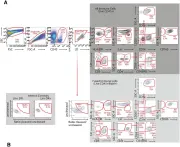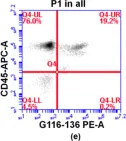Infection with the hepatitis B virus (HBV) is a key risk factor for hepatocellular carcinoma (HCC) development and progression. It is widely recognized that immunopathological mechanisms are pivotal in the development of HBV-associated HCC; nevertheless, the specific underlying mechanisms through which HBV-induced modifications within the tumor microenvironment (TME) contribute to HCC pathogenesis have yet to be fully elucidated. In the present study, single-cell RNA sequencing was utilized to analyze and compare the immune landscapes between HBV-positive and HBV-negative HCC. These experiments revealed that HBV infection significantly modifies the composition and state of immune cells, leading to the suppression and exhaustion of T cells within the TME. Specifically, increases in the proportions of SLC4A10+ CD8+ T cells and IFITM3+ macrophages were observed, along with an upregulation of the gene SLC35F1 in various immune cell subtypes. Taken together, these findings have offered valuable insights into the alteration of the immunological microenvironment in HCC that is associated with HBV infection, suggesting possible targets for immunotherapeutic intervention.
Copyright: © 2025 Liu et al.
Product Citations: 214
In Molecular and Clinical Oncology on 1 September 2025 by Liu, K., Chen, E., et al.
-
Cancer Research
-
Immunology and Microbiology
In International Journal of Stem Cells on 5 August 2025 by Kim, C., Park, K. H., et al.
Induced pluripotent stem cells (iPSCs) are a promising cell source for regenerative medicine. Clinical applications require a large number of functional red blood cells (RBCs), making it essential to ensure the proliferation of actively dividing, nucleated erythroblasts derived from iPSCs. Small molecules can enhance the efficiency and frequency of iPSC-derived cell differentiation. Sirtuin 1, a key enzyme in multiple biological processes, has been implicated in enhancing iPSC-derived cell differentiation. However, the specific effects of Sirtuin 1 on erythroblast proliferation from iPSCs remain unclear. Here, we developed a protocol to examine the effects of Sirtuin 1 on erythroblasts after endothelial-to-hematopoietic transition (EHT). We found that Sirtuin 1 activation increased the frequency of CD71+CD235a+ erythroblasts at the early stage after EHT, suggesting a role for Sirtuin 1 in the proliferation of these specified erythroblasts. These findings reveal that Sirtuin 1 activation benefits erythroblast proliferation and could be considered for translational application in large-scale RBC culture.
-
Stem Cells and Developmental Biology
Microbial metabolite drives ageing-related clonal haematopoiesis via ALPK1.
In Nature on 1 June 2025 by Agarwal, P., Sampson, A. M., et al.
Clonal haematopoiesis of indeterminate potential (CHIP) involves the gradual expansion of mutant pre-leukaemic haematopoietic cells, which increases with age and confers a risk for multiple diseases, including leukaemia and immune-related conditions1. Although the absolute risk of leukaemic transformation in individuals with CHIP is very low, the strongest predictor of progression is the accumulation of mutant haematopoietic cells2. Despite the known associations between CHIP and increased all-cause mortality, our understanding of environmental and regulatory factors that underlie this process during ageing remains rudimentary. Here we show that intestinal alterations, which can occur with age, lead to systemic dissemination of a microbial metabolite that promotes pre-leukaemic cell expansion. Specifically, ADP-D-glycero-β-D-manno-heptose (ADP-heptose), a biosynthetic bi-product specific to Gram-negative bacteria3-5, is uniquely found in the circulation of older individuals and favours the expansion of pre-leukaemic cells. ADP-heptose is also associated with increased inflammation and cardiovascular risk in CHIP. Mechanistically, ADP-heptose binds to its receptor, ALPK1, triggering transcriptional reprogramming and NF-κB activation that endows pre-leukaemic cells with a competitive advantage due to excessive clonal proliferation. Collectively, we identify that the accumulation of ADP-heptose represents a direct link between ageing and expansion of rare pre-leukaemic cells, suggesting that the ADP-heptose-ALPK1 axis is a promising therapeutic target to prevent progression of CHIP to overt leukaemia and immune-related conditions.
© 2025. The Author(s).
-
Cell Biology
In Frontiers in Medicine on 15 May 2025 by Colić, J., Pruner, I., et al.
To assess in patients with systemic sclerosis (SSc) the concentration of different subpopulations of circulating extracellular vesicles (EVs) and their association with the progression of interstitial lung disease (PF-ILD).
The prospective study included 59 SSc cases, 54% with interstitial lung disease (ILD). Plasma levels of EVs were analysed with flow cytometry and labelled as endothelial (EEVs), platelet (PEVs), leucocyte (LEVs), and EVs, expressing ICAM1, TF, or HMGB1. The presence of ILD was defined by HRCT. Lung functional tests were done every 3-6 months over a 3-year follow-up period. PF-ILD was defined as ≥10% decline of FVC % from baseline, or ≥5-9% along with a decline in DLCO of ≥15%.
At baseline, 32/59 SSc patients had ILD, with a median disease duration of 3 years, and 38% were therapy naïve. In ILD patients, increased levels of all investigated EVs were found in respect to SSc patients without ILD (p < 0.05). Therapy naïve ILD cases had altered only ICAM1 + EVs compared to treated (p < 0.05). Multivariate regression analysis (MR) showed an independent association of PEVs (OR 1.004, 95% CI 1.001-1.01) and ICAM1 + EVs (OR 1.3, 95% CI 1.1-1.5) with ILD. During the follow-up period, 12/32 ILD patients developed PF-ILD, and in this group, the levels of all explored EVs were elevated compared to those without PF-ILD (p < 0.05). In an ROC analysis, all EVs showed a good ability to identify PF-ILD patients (p < 0.05). Cox MR confirmed the independent predictive value of ICAM1 + EVs (HR 1.1, 95% CI 1.01-1.1) with SSc PF-ILD.
Circulating EV levels are increased in SSc and correlate with ILD. In particular, ICAM1 + EVs may be a novel biomarker of PF-ILD, identifying SSc patients at high risk of progression who may require early aggressive treatment. Based on our results, the role of EVs in the pathogenesis and progression of ILD should be investigated further.
Copyright © 2025 Colic, Pruner, Damjanov, Antovic, Sefik-Bukilica, Cerinic and Antovic.
In Frontiers in Immunology on 1 May 2025 by Kaginkar, S., Remling-Mulder, L., et al.
While HIV-1 subtype C (HIV-1C) is the most prevalent and widely distributed subtype in the HIV pandemic, nearly all current prevention and therapeutic strategies are based on work with the subtype B (HIV-1B). HIV-1C displays distinct genetic and pathogenic features from that of HIV-1B. Thus, treatment approaches developed for HIV-1B need to be suitably optimized for HIV-1C. A suitable animal model will help delineate comparative aspects of HIV-1C and HIV-1B infections.
Here, we used a humanized mouse model to evaluate HIV-1C infection, disease progression, response to anti-retroviral therapy (ART) and viral rebound following therapy interruption. A limited comparative study with a prototypical subtype B virus was also performed. Viral infection, immune cell dynamics, acquisition of anti-retroviral therapy (ART) resistance and anatomical reservoir distribution following extended and interrupted therapy were compared.
In comparison, lower early plasma viremia was observed with HIV-1C, but with similar rate of CD4+ T cell depletion as that of HIV-1B. Viral suppression by ART was delayed in the HIV-1C infected group with evidence, in one case, of acquired class wide resistance to integrase inhibitors, a critical component of current global therapy regimens. Also, HIV-1C infected animals displayed faster rebound viremia following ART interruption (ATI). Disparate patterns of tissue proviral DNA distribution were observed following extended ART and ATI suggestive of distinct sources of viral rebound.
In this preliminary study, discernible differences were noted between HIV-1C and B with implications for prevention, therapeutics and curative strategies. Results from here also highlight the utility of the hu-HSC mouse model for future expanded studies in this context.
Copyright © 2025 Kaginkar, Remling-Mulder, Sahoo, Pandey, Gurav, Sutar, Singh, Barnett, Panickan, Akkina and Patel.
-
Immunology and Microbiology
In PLoS One on 23 August 2019 by Cavrois, M., Hilton, J. F., et al.
Fig.1.A

-
FC/FACS
-
Homo sapiens (Human)
Collected and cropped from PLoS One by CiteAb, provided under a CC-BY license
Image 1 of 2
In Int J Mol Sci on 11 May 2019 by Shen, N., Song, G., et al.
Fig.3.E

-
FC/FACS
-
Homo sapiens (Human)
Collected and cropped from Int J Mol Sci by CiteAb, provided under a CC-BY license
Image 1 of 2

